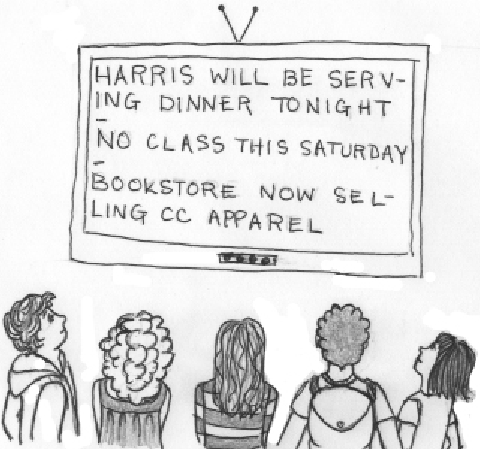
Potential messages to be displayed on SGA's proposed digital signage. Illustration by Alicia Toldi.
Back in the eighties, people thought that by the year 2000 everyone would own jetpacks, hovercrafts would replace automobiles and we would all wear chrome. Now it’s easy to point to the past, laugh and say to each other, “Wow, people were so stupid then.” What’s jarring is that participants in this hypothetical conversation make eye contact from thousands of miles away via Skype while simultaneously surfing the Internet from virtually anywhere on their pocket-sized $600 smart phones. Yeah, that old future is still SO far off, right? The truth is that it isn’t.
Jetpacks and hovercrafts exist. They’ve been around for years now: they’re just unrealistically expensive, dangerous and most importantly, completely ridiculous. In addition to this, you can wear chrome all you want, just don’t expect a social life in return. What I’m trying to say is that yesterday’s possible has become the probable, but there are many cases (see above: Skype) when technology advances beyond itself, or at least beyond the realm of the currently necessary.
If you check all of your e-mail every day, then you may be aware of the Student Government Association’s (SGA) plan to bring digital signs to parts of the campus in order to better promote events. Sounds like a harmless enough idea, but in a school where we literally get a weekly dose of news every time we sit on the toilet, is it entirely necessary?
The first thing I did when I heard the term “digital signage” was to type it into Microsoft Word to see if signage is actually a word. Imagine my surprise to find out it is! Digressions aside, what would these signs really be? They would be large, wide, rectangular and expensive flat screen televisions most likely put up in Cro and Harris. They would probably be set to a channel that would probably play a ticker of upcoming campus events and news twenty-four hours a day, seven days a week. Do we need this? Let’s tune out the initial obligatory outcry of the energy-obsessed environmentalists for two seconds and consider what deficiency these screens would fill: a deficiency of promotion.
Does the college have a deficiency of promotion? In addition to everyone’s e-mail inbox, we’ve got the Daily CONNtact, the College Voice, the notorious CollegiateLink and SGA’s On the Can, not to mention various posters, bulletin boards and of course the most energy efficient of all forms of promotion: word of mouth. All of these things promote events on (and off) campus. I suppose the point of these signs is to fill in the cracks in this system that leave people uninformed of events they would have gladly signed up for but did not know were going on. Has anyone missed something they would’ve absolutely loved to attend because they had absolutely NO idea it was happening? I haven’t, so I asked a couple of students if they had.
Some gave me a flat “no.” One student, however, told me that she had missed a club hockey game that she would’ve liked to have attended simply because there was nothing about it posted anywhere (that she could see). This could mean two things: it could mean that she wasn’t looking hard enough, or it could mean that club hockey didn’t promote their game particularly well, which is also a possibility.
I myself have been told to promote an event only to fall very short of the five-or-six-posters-in-south campus requirement. On the flipside, I’ve seen people hang posters on the windows in Harris, a reasonable decision considering that a majority of the campus will see them, only for them to be taken down because of that silly no-posters-on-glass-surfaces rule. In that case, maybe the digital signs wouldn’t hurt.
Or would they? Let’s tune back in to the environmentalist position. For the people that feel the need to self-flagellate every time they open their refrigerator for more than a few seconds, these screens may not be particularly popular. If leaving on two or three flat screen televisions wastes energy and subsequently results in the early death of four phytoplankton living somewhere off the coast of New Zealand, you can bet somebody will have a problem with it, and with an overall college sustainability report of B+ (gasp!), that somebody may actually have a point.
These screens could actually save quite a bit of poster paper, so in another sense, they might actually be environmentally friendly. It all depends on how you look it at. Speaking of looking at it, one of my biggest worries is that these screens will go largely ignored. I hope whoever places these things is smart enough to do it in an area where we not only inevitably look but also don’t have much else to look at. With any luck it won’t be in front of a door or something; imagine a bunch of people gathered like moths to a flame staring up a screen, waiting for the event they think they might’ve seen to tick by again while people push through them awkwardly.
On the other hand, maybe I’m wrong, and it’ll all work out fine. Hopefully it will. But taking into consideration the fact that bulletin boards to digital signs are analogous to regular picture frames and those utterly unnecessary and pricey digital picture frames, I think people should really give some consideration as to whether or not this particular purchase is, at the moment, absolutely necessary. •








